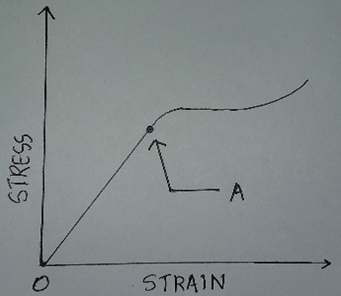This set of Aerospace Materials and Processes Multiple Choice Questions & Answers (MCQs) focuses on “Physical Terms and Test Terms”.
1. The property of being liquefied due to heat is known as ______
a) stress
b) contraction
c) normalizing
d) fusibility
View Answer
Explanation: The property of being liquefied due to heat is known as fusibility. Contraction is the reduction in length of material and stress is the load on the material.
2. The ‘A’ in the image represents _______

a) proportional limit
b) yield point
c) conductivity
d) rupture strength
View Answer
Explanation: The point is called the proportional limit. Beyond the proportional limit, stress is not proportional to strain. Yield point denotes the point after which the material turns to plastic. Rupture strength and yield point occur after the proportional limit.
3. Hardness is inversely proportional to strength.
a) True
b) False
View Answer
Explanation: Hardness is directly proportional to strength. As the hardness of a material increases, it’s strength increases. Hardness is the tendency of a material to resist penetration. Strength of a material is its capacity to withstand a load.
4. Which of the following property of a material is preferred in the construction of an aircraft?
a) Ductility
b) Elasticity
c) Hardness
d) High density
View Answer
Explanation: Ductility, elasticity and hardness are all preferred in the construction of an aircraft. High density is not preferred. Instead, low density is preferred.
5. What is the temperature at which steel fuses?
a) 1100°F
b) 200K
c) 2500°F
d) 3500°F
View Answer
Explanation: Steel fuses at around 2500°F. Aluminium alloys fuse at around 1100°F. Fusibility is the liquefaction of a material due to heat.
6. Why do metals contract and expand?
a) Due to cooling and heating
b) Due to displacement
c) Due to repairs
d) Due to false recognition
View Answer
Explanation: The cooling and heating of metals causes contraction and expansion respectively. That is the reason why railway tracks expand in summer.
7. A material elongated to 35m due to certain conditions. If it’s initial length is 7m, what is the strain of the material?
a) 21m
b) 5m
c) 7m
d) 35m
View Answer
Explanation: Strain = \(\frac{Change \,in \,length}{Original \,length}
= \frac{35}{7}\) = 5m.
8. The tendency of a material to fracture without changing it’s shape is known as ______
a) brittleness
b) hardness
c) elasticity
d) carburizing
View Answer
Explanation: The tendency of a material to fracture without changing it’s shape is known as brittleness. Hardness of a material is its tendency to resist penetration. Elasticity of a material is the property of the material to return to its original shape once the force causing the distortion of shape is removed.
9. Steel is one of the few materials that has a definite yield point.
a) True
b) False
View Answer
Explanation: The yield point is a point after which there is an increase in deformation without a load increase. Steel is one the few materials that has a definite yield point.
10. If a material is loaded beyond its elastic limit _________
a) it returns back to it’s original shape
b) it acquires softness
c) it is permanently distorted
d) it turns to liquid
View Answer
Explanation: If a material is loaded beyond its elastic limit, it is permanently distorted. Elastic limit is the extent up to which a material can withstand stress without deforming permanently.
11. The property of a material involving transmitting of heat or electricity is known as _________
a) expansion
b) stress
c) contraction
d) conduction
View Answer
Explanation: The property of a material involving transmitting of heat or electricity is known as conduction. It is also a property to be considered in aircraft electrical bonding.
12. The load obtained in a tension test is 500N and the original cross sectional area is 250m2 what is the tensile strength of the material?
a) 5 m
b) 25 N/m2
c) 2 N/m2
d) 20 m
View Answer
Explanation: Tensile strength = \(\frac{Maximum \,load \,obtained}{Original \,cross-sectional \,area}\)
= \(\frac{500}{250}\) = 2 N/m2.
13. The modulus of elasticity of a material can be described as ________
a) the product of stress and strain
b) the ratio of stress to strain
c) the product of yield point and strain
d) the ratio of change in length to original length
View Answer
Explanation: The ratio of stress to strain is called the modulus of elasticity (within the elastic limit). The ratio of change in length to original length is called strain.
14. The ability of a material to resist permanent distortion or penetration is called as _______
a) hardness
b) yield point
c) malleability
d) elongation
View Answer
Explanation: The ability of a material to resist permanent distortion or penetration is called hardness. Elongation is the increase in the length of a material. Malleability allows materials to bend without rupture.
15. What is the total permissible elongation for a gage length of 5.08cm?
a) 5080 cm
b) 0.00508 cm
c) 0.508 cm
d) 0.000508 cm
View Answer
Explanation: The proof stress is the load a material can endure without permanent distortion of more than 0.0001cm per 1cm. So, if the gage length is 5.08cm, the total permissible elongation would be – 5.08×0.0001 = 0.000508cm.
Sanfoundry Global Education & Learning Series – Aerospace Materials and Processes.
To practice all areas of Aerospace Materials and Processes, here is complete set of 1000+ Multiple Choice Questions and Answers.
If you find a mistake in question / option / answer, kindly take a screenshot and email to [email protected]
- Check Aerospace Engineering Books
- Check Aerospace Materials Books
- Check Aeronautical Engineering Books
- Practice Aeronautical Engineering MCQs
- Apply for Aerospace Engineering Internship
